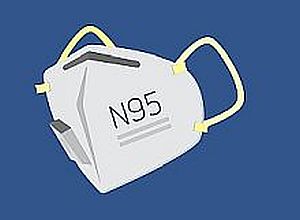Owners of electric multicookers may be able to add another use to its list of functions, a new study suggests: sanitisation of N95 respirator masks. The University of Illinois, Urbana-Champaign study found that 50 minutes of dry heat in an electric cooker, such as a rice cooker or Instant Pot, decontaminated N95 respirators inside and out while maintaining their filtration and fit. This could enable wearers to safely reuse limited supplies of the respirators, originally intended to be one-time-use items.
Researchers were led by civil and environmental engineering professors Thanh “Helen” Nguyen and Vishal Verma.
N95 respirator masks are the gold standard of personal protective equipment that protect the wearer against airborne droplets and particles, such as the coronavirus that causes COVID-19. “A cloth mask or surgical mask protects others from droplets the wearer might expel, but a respirator mask protects the wearer by filtering out smaller particles that might carry the virus,” Nguyen said.
High demand during the COVID-19 pandemic has created severe shortages for health care providers and other essential workers, prompting a search for creative approaches to sanitisation.
“There are many different ways to sterilise something, but most of them will destroy the filtration or the fit of an N95 respirator,” Verma said. “Any sanitation method would need to decontaminate all surfaces of the respirator, but equally important is maintaining the filtration efficacy and the fit of the respirator to the face of the wearer. Otherwise, it will not offer the right protection.”
The researchers hypothesised that dry heat might be a method to meet all three criteria – decontamination, filtration and fit – without requiring special preparation or leaving any chemical residue. They also wanted to find a method that would be widely accessible for people at home. They decided to test an electric cooker, a type of device many people have in their pantries.
They verified that one cycle on their model's rice-cooking pre-set, which maintains the contents of the cooker at around 100 degrees Celsius or 212 Fahrenheit for 50 minutes, decontaminated the masks, inside and out, from four different classes of virus, including a coronavirus – and did so more effectively than ultraviolet light. Then, they tested the filtration and fit.
“We built a chamber in my aerosol-testing lab specifically to look at the filtration of the N95 respirators, and measured particles going through it,” Verma said. “The respirators maintained their filtration capacity of more than 95% and kept their fit, still properly seated on the wearer’s face, even after 20 cycles of decontamination in the electric cooker.”
The researchers created a video demonstrating the method.
They note that the heat must be dry heat – no water added to the cooker, the temperature should be maintained at 100 degrees Celsius for 50 minutes and a small towel should cover the bottom of the cooker to keep any part of the respirator from coming into direct contact with the heating element. However, multiple masks can be stacked to fit inside the cooker at the same time, Nguyen said.
The researchers see potential for the electric-cooker method to be useful for health care workers and first responders, especially those in smaller clinics or hospitals that do not have access to large-scale heat sanitisation equipment. In addition, it may be useful for others who may have an N95 respirator at home – for example, from a pre-pandemic home-improvement project – and wish to reuse it, Nguyen said.
The Environmental Protection Agency and the US Department of Agriculture supported this work.
Abstract
A pandemic such as COVID-19 can cause a sudden depletion of the worldwide supply of respirators, forcing healthcare providers to reuse them. In this study, we systematically evaluated dry heat treatment as a viable option for the safe decontamination of N95 respirators (1860, 3M) before their reuse. We found that the dry heat generated by an electric cooker (100 °C, 5% relative humidity, 50 min) effectively inactivated Tulane virus (TV, >5.2-log10 reduction), rotavirus (RV, >6.6-log10 reduction), adenovirus (AdV, >4.0-log10 reduction), and transmissible gastroenteritis virus (TGEV, >4.7-log10 reduction). The respirator integrity (determined on the basis of the particle filtration efficiency and quantitative fit testing) was not compromised after 20 cycles of a 50 min dry heat treatment. On the basis of these results, dry heat decontamination generated by an electric cooker (rice cookers, instant pots, and ovens) could be an effective and accessible decontamination method for the safe reuse of N95 respirators. We recommend users measure the temperature during decontamination to ensure the respirator temperature can be maintained at 100 °C for 50 min.
Authors
Chamteut Oh, Elbashir Araud, Joseph V Puthussery, Hezi Bai, Gemma G Clark, Leyi Wang, Vishal Verma, Thanh H Nguyen
[link url="https://news.illinois.edu/view/6367/143865832"]University of Illinois, Urbana-Champaign material[/link]
[link url="https://pubs.acs.org/doi/full/10.1021/acs.estlett.0c00534"]Environmental Science & Technology abstract[/link]
[link url="https://www.youtube.com/watch?v=o7-k0EIR0To"]Video[/link]

